As this is posted the group has returned to the familiarity of the National Olympic Village in Tokyo. Students are anticipating completing their final projects and visiting their favorite areas of Tokyo one last time before we depart on Saturday. Today’s post contains some of the student writing based on our five days in Kyoto.
Ben Winick’s photo
Will Grant on Japanese Architecture and Dress
It is far more common to see examples of traditional Japanese architecture and dress in the city of Kyoto than it is in Tokyo. The latter seems to be an organism that constantly sheds old skins and modes to rebuild its identity, while maintaining the integral underpinnings of Japanese culture and codified interpersonal relations. Kyoto, on the other hand, might also be modernized (one doesn’t have to wander far to see the all-too familiar Burger King, McDonalds, or H&M clothing line) but has retained far more of the traditional buildings, structures and habits of ancient Japanese society. Without exaggeration there are probably more Buddhist or Shinto shrines—each dating back centuries–per square mile than Starbucks in Manhattan, which is saying something. There are whole districts, such as the winding streets that lead up to the Kiyomizu-dera temple, where classic Japanese architecture is preserved and people live in traditional styled homes. The temples themselves are maintained impressively and demonstrate many of the old aesthetic qualities such as iki (subtle elegance) and furyu (stylish elegance). Kiyomizu-dera, for example, had many pleasing and geometrically balanced roofs that demonstrate simplicity complemented by intricate details as well as opulent gold colors. Walking up high on the hill and being surrounded by the presence of tranquility and natural spirits, one feels a part of the ukiyo or “floating world” described in the Edo period of Japan. There is sensory and emotional delight experienced as well as a sense of detachment from the rest of society when one comes to this place of worship. Traditional Japanese customs are preserved also in terms of style and fashion, as we have encountered many individuals wearing fine kimonos with stylish patterns and interesting compositional aesthetic elements. Many display iki and elegance with their detailed patterns and bold flamboyant colors.
Clark Gegler on Shigaraki Yakimono Village & Eating Pufferfish
Note from Christie: The Japanese word for pottery is Yakimono. Yaki=burnt or barbecued and Mono=Things.
Yesterday was another amazing day, going up into the mountains to find the pottery village; even though it rained all day it could not stop us from finding the Cultural Center. On the way up to the village, as we passed the mountains I could see why they are so prominently featured in the artwork with steam rising between them– it was awe inspiring. The outside of our train was highly decorated with art by students from an art college and was only two cars long. The Ceramic Cultural Center and Park was really cool with huge industrial furnaces and massive pieces of ceramic artwork on display. I had the good fortune to meet one of the artists who was coming back to lunch and she gave us a tour of the studios.
There were tons of tanuki sculptures around where we traveled and as we left the train station we saw a bunch arranged to look like they were saying farewell. When we finally made it back to Kyoto I decided along with a fellow student to go out and test our might against the fearsome pufferfish and enjoyed a nice plate of pufferfish sashimi and sushi, with some plum and pufferfish sake. While it was a bit expensive (the whole meal cost about $30 for 3 small plates and 2 drinks) I wholeheartedly recommend people try it because the taste is like nothing I’ve ever had before.
 Ben Garrett’s photo of the train
Ben Garrett’s photo of the train
Emily Motter on Japanese Language and Shodo
Japanese language is not something that I gave much thought to before I came to Japan. In fact, I never really thought about Japanese culture in general. I am not an anime person and I never really liked Japanese food, so I never had a medium to really get started looking at Japanese culture. Since being here, one of the things that has really captured my attention is the Japanese language in its verbal and written form. After adapting kanji from the Chinese in order to have their own written language, the Japanese have since put a large emphasis on the art of writing. There are three different alphabets, and each one has a different background. I think the language itself is interesting, but what I really love is shodo, or the way of calligraphy. There is an art to writing out Japanese with a brush and ink. Just like every other art form in Japanese culture, a person must specialize in shodo in order to master the skill of good calligraphy. Having such skill really says a lot about a person and his/her personality. It goes back to the idea in Japanese culture that beauty is found in the little everyday things, in the way something is made. Yes, calligraphy was on display at the Tokyo National Museum but it was originally just a part of everyday life, just like our handwriting. There is an emphasis on presentation that I really admire in Japanese culture because it makes little things beautiful and interesting. Art is everywhere rather than behind guarded doors where you can look but you can’t touch.
Emily Motter’s Reflection on Japanese Gardens
I tried my hand at finding my inner zen at Ryoan-Ji. Zen gardens are heavily integrated with typical Japanese culture. The Japanese have certain rituals for everyday things, and so of course there is a ritual in how to keep a rock garden. One must rake the rocks every day into a new pattern, and this is used for the ritual of meditation. There was also an overwhelming sense of wa (harmony) there if you were able to get to a quiet place to really take in the beauty of the garden. I thought about the number of different life forms living in one small area and how that is world-wide, not just exclusive to this one garden. Eli, at the beginning of the trip, made a joke about how it is amazing how moss grows because somehow the roots of a tree make the perfect habitat for another lifeform to grow. Though this was a joke, I do think there is something beautiful in that. In this garden, people from all over the world were coming to see and share an experience, living in harmony for a brief moment in time.
Katie Godowski on the Tea Ceremony
The tea ceremony was the calmest and most relaxed 45 minutes of my life that I have felt for the past few days as we have been constantly going about. It was a simple ceremony in a back alley in a room that was cream colored with wood paneling. The two women wearing kimonos went about their tea routine, talked us through what they were about to do and shared the history of the ceremony. The group of 11 people sat quietly and watched the beautiful ceremony being conducted. The elegance of the ceremony as well as the rusticity were perfect, as both of the women in kimonos have been doing tea ceremonies for years, even went to school for it. The young kimono wearing women subtlety mentioned not to talk about politics or religion as those are not calming things, but to talk about the art and culture that surrounds us every day.
There are numerous steps to how a tea ceremony is done, from how the hot water is made (using coals) to how to stir the green tea the correct way. Each step is precise and well done with almost a fluid brushwork, as it is smooth and flowing. Once the ceremony was over, we all got up and thanked the women and left. We all talked about how it was a relaxing few minutes, but once we walked back into the busy street, it was almost as though the event did not happen.
Benjamin Garrett on Visiting Fushimi Inari Shrine
Today we went to Fushimi Inari Taisha Shrine in Fushimi-Ku, Kyoto, Japan. It is dedicated to the god of rice, Inari. It was something else, unlike any other shrines we saw. The hundreds of torii gates there were donated by businesses and they went all the way up a mountain leading you to the top of the mountain. The fox statues (Kitsune) there guarding the gates are regarded as messengers of the kami Inari. There are two main theories on how these kitsune became Inari’s servants. One is a myth from Buddhist text, from the 14th century, telling of a family of foxes who traveled to the shrine at Inari mountain to offer their services to Inari. The request was granted and they were placed at the shrines. The second theory comes from the behavior of living foxes. They are often seen in and out of fields of rice during growing season, eating rodents that would otherwise eat the rice. Their behavior pattern gave foxes an image of being guardians of the field. Also, the fox’s color looks like a ripened grain of rice, as well as their tails looking like a grain of rice. This all adds to why there are foxes guarding the shrine. This shrine was beautiful, so much flowing orange it overtook you as you made your way through the torii to the top of the shrine. The more you hiked it, the more vegetation appeared, bamboo and seemingly endless woods all around as I continued to hike up. Once we made our way to the top, we purified ourselves with the sacred water and hiked up the steps to the shrine there. The view there was something else. You could see all of Kyoto and the mountains that surrounded it. We rang the bell and paid our respects. We then decided to continue our way down.
Isaac Alam on Japan & Religion
As our days in Kyoto came to an end we ended it with a big finish, by going to one of most famous places in Kyoto. We went to the Fushimi Inari Taisha. Seeing all of the colors and so many people stopping to take pictures was an experience. By that I mean many people are inspired by the location and what it symbolizes for them. I feel as if some people go for historical reasons, but some people go because they have a spiritual connection with who they are praying to and what wishes they want to be sent out for good karma, energy and vibes. This is very touching and amazing to see, when you get to see how people pray and how different it is. I saw many people stand in line to pick up what looked like a stone but also marble ball. They would put their hands together and then say a prayer, then pick up the ball once and place it back. People would also do another prayer and ring a bell and after they were done they threw money. Also you are able to donate and get a paper that says your future and a brief way of saying what’s ahead of you in life as well. I get the feeling that people do this because it makes them feel like something will connect along the way if they put it out there for a god to see or just energy to the world. I believe in that and if you put your mind on something that it can happen and everything will work out the way you want it to. Visiting this temple really made me want to figure out more about Shinto objects–what little things at shrines mean and their symbolism.
Ray Lounsbury on Fushimi Inari
Our morning started with yet another fantastic banquet for breakfast. After eating we headed to the station to board a train that would take us to Fushimi-Ku which is a series of shrines built into the side of a mountain. A large network of trails take visitors up the hill through countless toriis which are gate like structures which are typically red or orange. Having donated a specified about of money visitors could have their name and birth date carved into the side of these gates. There were about 5 stops along way which led to the summit each having a nearly identical restaurant.
There were many tourists from around the world but the majority were Korean or Chinese. It was tough getting around because many of these people were oblivious to the fact that the left side is the correct direction of travel. Many paths felt like Indian traffic jams. The most important part was everyone seemed to be relaxed in the serenity of the moment. I happily took pictures of countless fellow guests and they were happy to return the favor to me. So many Japanese were thrilled to hear I was from New York. Their faces lit up like lightning when I told them. They would excitingly yell out “New Yoooork????!!!!!!!
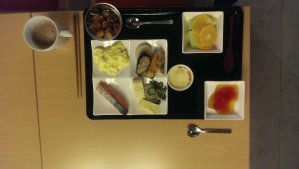
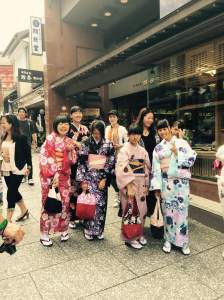
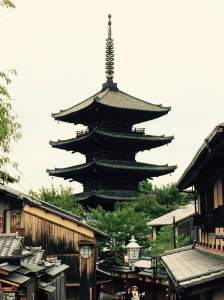


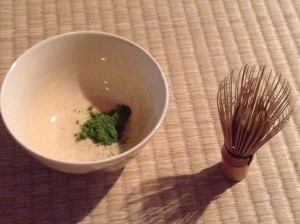
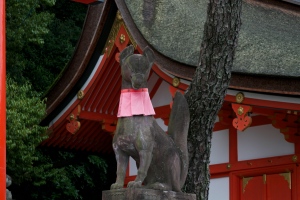
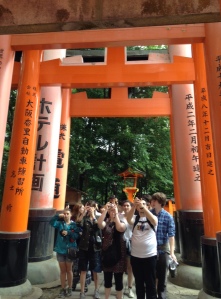
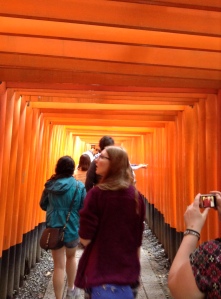
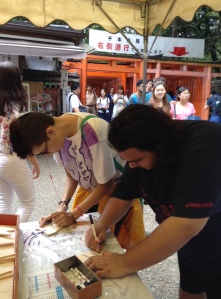
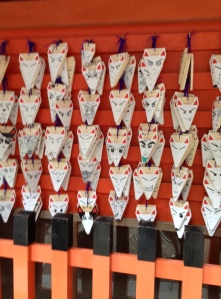
Such thoughtful and articulate journals from the students. Thanks for sharing. It sounds like this is a profound and life-changing experience for many.
LikeLike